Sitmar Line - SS Castel Felice History -
Page 1
Please
Note: Firefox,
iPhones,
iPads & some other Search Engines
may not be suitable
Use
Internet Explorer & Old Google
for this Web Page to load perfectly!

Click
the logo above to reach the ssMaritime FrontPage for News Updates
With
Reuben Goossens
Maritime
Historian, Cruise‘n’Ship Reviewer, Author & Lecturer
Please
Note: All ssmaritime and my other related
ssmaritime sites are 100% non-commercial and privately owned sites. Be assured
that I am NOT associated with any cruise or shipping companies or travel/cruise
agencies or any other organisations! The author has been in the passenger
shipping industry since May 1960 and is now semi-retired, but continues to
write article on classic liners and cruise ships in order to better to inform
cruise and ship enthusiasts for their pleasure!
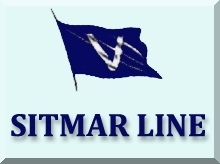
The
Sitmar Ships
Part
Two
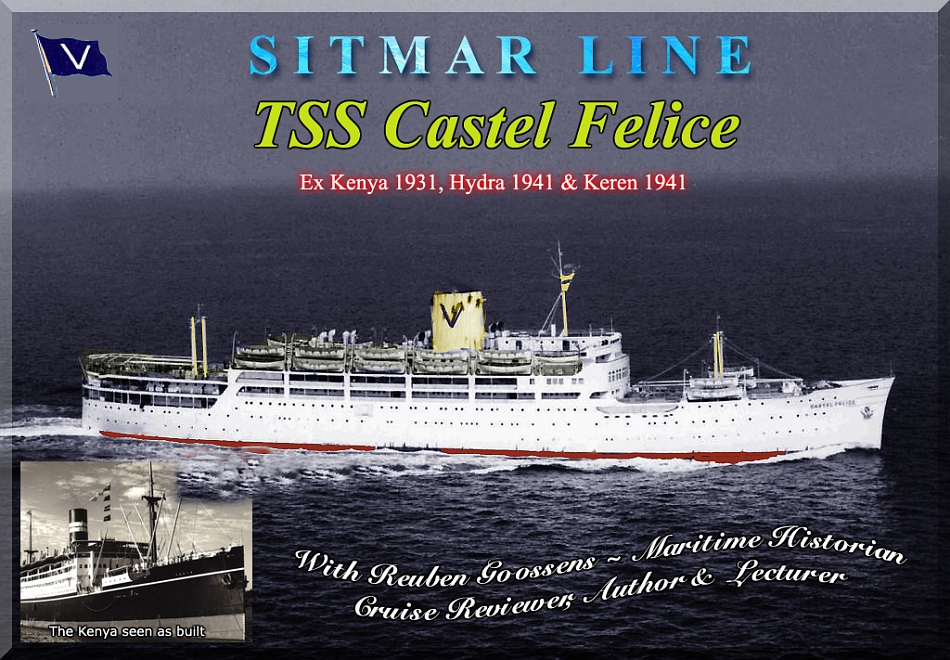
Note
the crew cleaning the ships funnel
Please Note: Unless marked otherwise, photographs and images on
this page are from the authors’ private collection
Introduction
to “The Sitmar Ships”:
Over the years
I have received unbelievable numbers of requests to add a feature on all the
Sitmar Liners and Cruise Ships. Well, it has taken a considerable time, but in
this work, I will present a short history on each ship, together with a number
of photographs. Therefore, I hope and pray that the following pages will have
you reliving your Sitmar experience or possibly experiences, be it sailing to
or from Europe/UK to New
Zealand or Australia
or the America’s
on a line voyage or later as a passenger on one of their many cruises!
I certainly have enjoyed writing and compiling
this very special feature on a company that I greatly love and have sailed with
many times!
Thus now go and read all about … The Sitmar Ships.
Reuben
Goossens.
TN
Castel Felice, ex Kenya
Built in 1930
It is obvious that although at
12,150 GRT (Gross Registered Tons) Sitmar’s Castel Felice was a
relatively small liner, nut she had excellent facilities and certainly a most
pleasant, if not a somewhat classic profile, which was a pleasing one!
However, she was originally built in
1930 for the British India Company as the Kenya
by “A. Stephen & Sons, Glasgow and was she launched on August 27,
1930. This ship was designed to operate on the company’s Indian Ocean
service from Bombay to East
Africa and Durban.
As she was completed just four months later, the SS Kenya commenced her maiden
voyage on December 18, 1931 and she headed for Bombay.
She offered sixty-six berths in First
Class and Hundred and twenty in Second Class both having pleasant public
facilities and ample deck spaces. In addition to this, there was also space for
up to 1,700 Third Class, come deck passengers. This area offered the most basic
of accommodations indoors as well a deck spaces, and was only sold only to
Indian as well as African passengers many who would sail on short voyages.
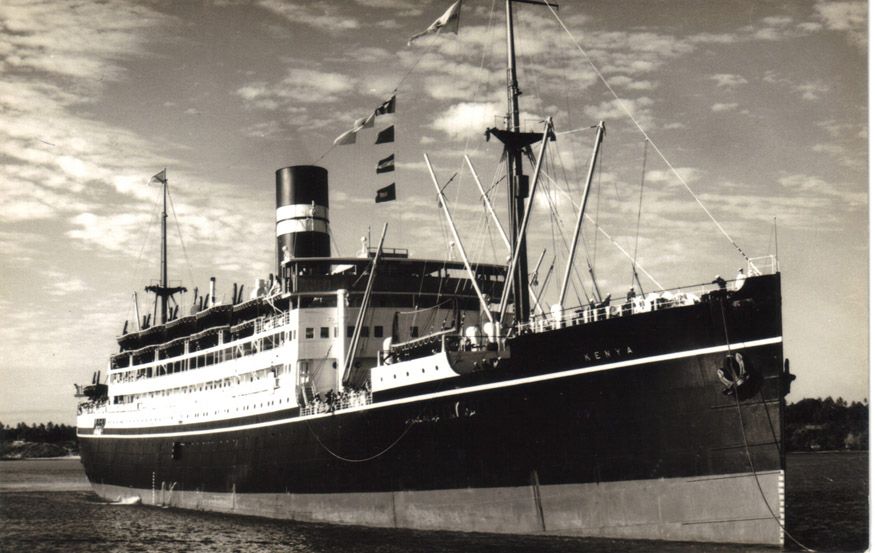
Seen
as the British India Company - SS Kenya
In
1940 she was seconded and she was refitted as the troopship HMS Kenya, but
later she was again refitted as an infantry-landing vessel, and was renamed HMS
Hydra in 1941. Then she was commissioned into the Royal Navy on July 23, 1942
to became an Infantry landing ship and she was renamed HMS Keren due to a naval
ship, a cruiser that was already in operation in the navy with her previous
name. She was fitted with 22 anti-aircraft guns and was one six-inch and one
three-inch guns, and she was able to carry 1,296 soldiers, and she would have a
crew of 297. Located on each side of the ship were five landing craft that hung
along the side of the HMS Keren.
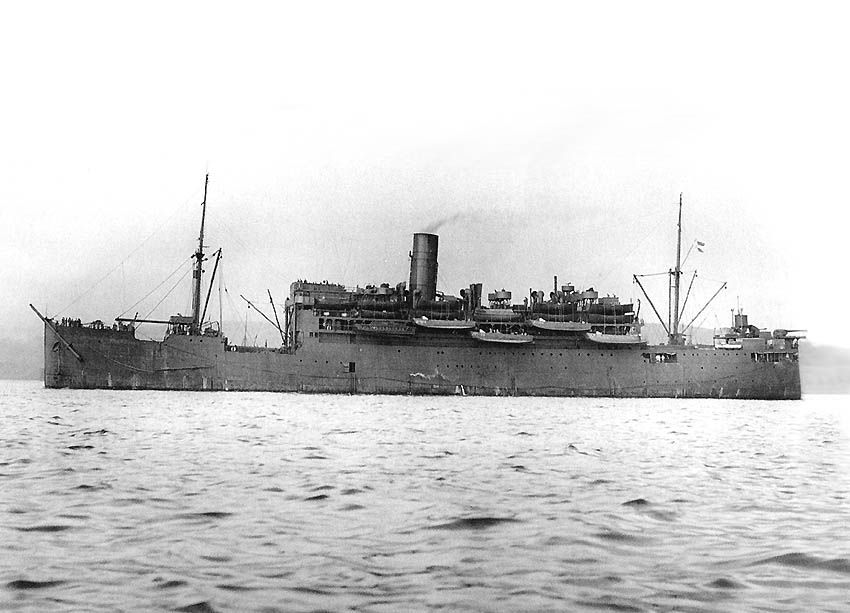
HMS Keren is seen as an armed “Infantry Landing
Ship”
After the war British
India decided to sell the ship and she was sold in
April 1946 to the Ministry of Transport however, in August 1948 she was laid up
in Holy Loch.
A New Life for the British Ship:
Early in 1949 the Vlasov Group
commenced negotiations to purchase the SS Keren, ex Kenya.
But sadly during the negotiations, on February 19, Keren broke loose from her
moorings during a storm and she was badly damaged. Having been refloated she
was taken to Glasgow to be
repaired and was renamed Kenya
again. But she remained laid up at Rothesay
Bay,
and she was renamed Keren once again, yet later that very same year her
original name Kenya
was restored to her, why all the name changes nobody knows?
In 1950 she was sold and registered
in Panama for
the Alva Steamship Co and was she was renamed “Fairstone,” at least
this was a Sitmar style name, but it would be changed in due course, But in
June 1950 and registered in Italy
by Sitmar Line in October 1950 and named once more the SS Kenya. Then in March
1951 she once again became the “Keren,” but this time for the very
last time.
On October 15 she was towed to Falmouth
where initial rebuilding commenced. She departed undertow on March 10, 1951,
heading for Antwerp,
where further work was undertaken. Finally, in August that year she headed for Genoa
again undertow, where she received her final special Italian touch from her
owners where she became a good looking ship with many new and modern comforts
on board.
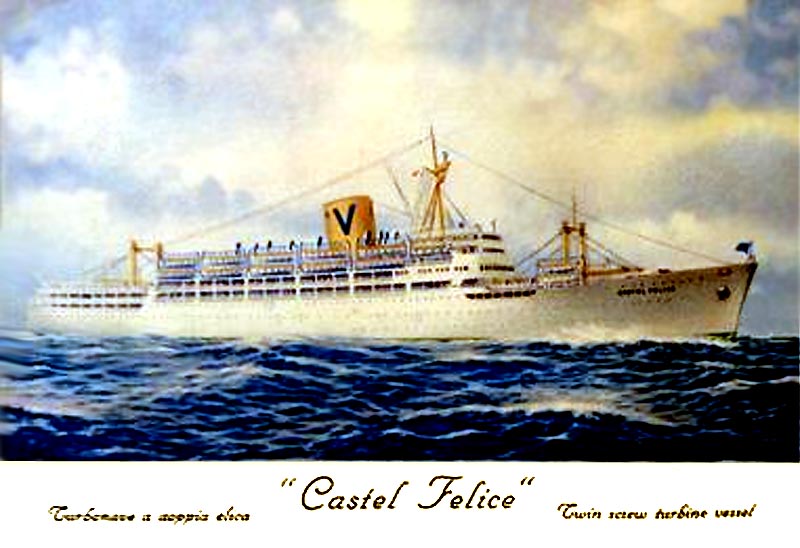
Here we
see Sitmar Line’s first artist impression postcard of their new SS Castel
Felice in 1952
Both her profile and interiors saw
countless changes. Her funnel was shortened, a new shapely raked bow was fitted
and her promenade deck was extended far aft. Her main masts were removed whilst
a new mast atop the bridge and King posts with derricks were added. Her
interiors were completely remodelled, with many new cabins added in her
completely remodelled hold spaces. When the ship was complete, she was able
accommodate up to 1,540 passengers, with 596 in Cabin Class and 944 in Third
Class (mostly for immigrants).
With her bright new look, this
gleaning white liner with her yellow funnel and the famous Sitmar blue
“V” logo was finally officially renamed the SS “Castel
Felice” in September 1952 and she was made ready for her maiden voyage.
SS Castle Felice departed Genoa
on October 6, 1952, for her maiden voyage to Australia,
arriving in Fremantle (Perth)
on November 1, she then arriving in Melbourne on November
5, and Sydney on the 7th. Upon
her return to Genoa she was
placed on the Italy South American service commencing in January 1953, then in
1954 she made several voyages to Canada
and the United
States. Later
in 1954 she made her second voyage to Australia.
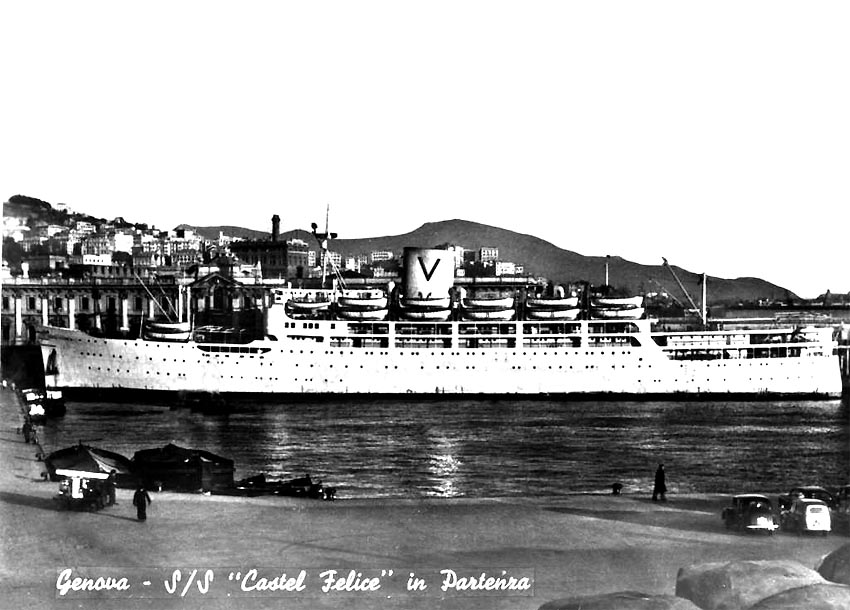
Here we
see the Castel Felice as she was first rebuilt and refitted in 1952 in Genoa
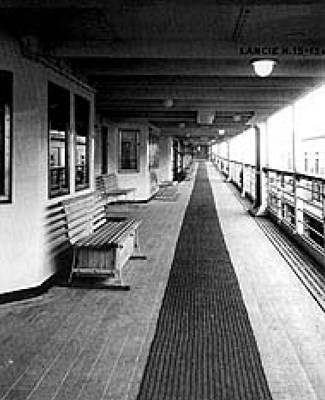
Promenade
Deck
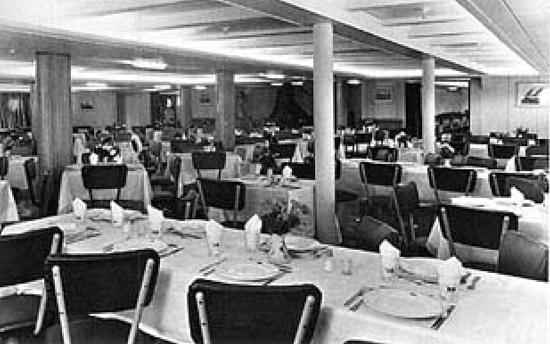
Forward
Dinning Room
Early
1955 air-conditioning was installed and accommodations were altered to
accommodate 28 First Class, and 1,173 Tourist Class passengers. Upon completion
the new look Sitmar Line flagship departed Genoa
on February 26, for her third Australian voyage, after which she retuned to her
previous South American service.
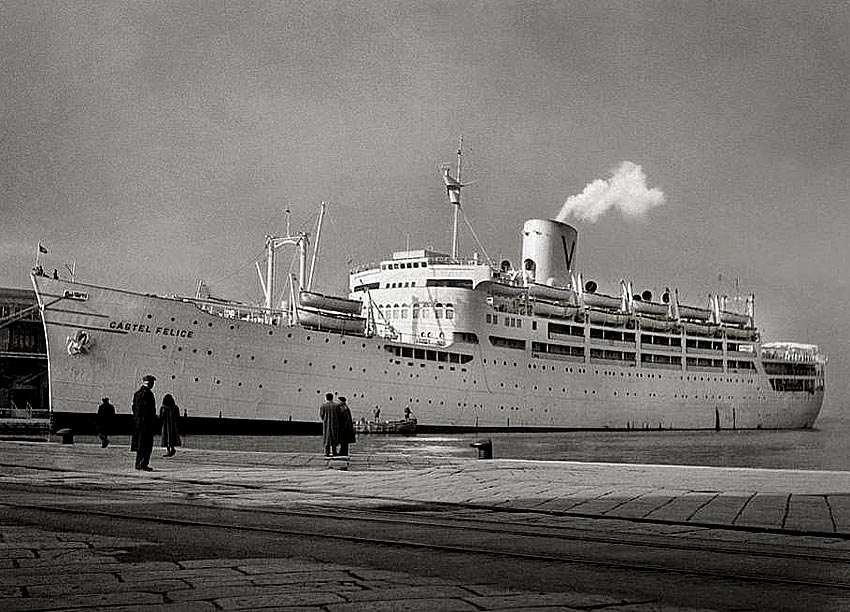
A
gleaming white Castel Felice is seen berthed in Southampton
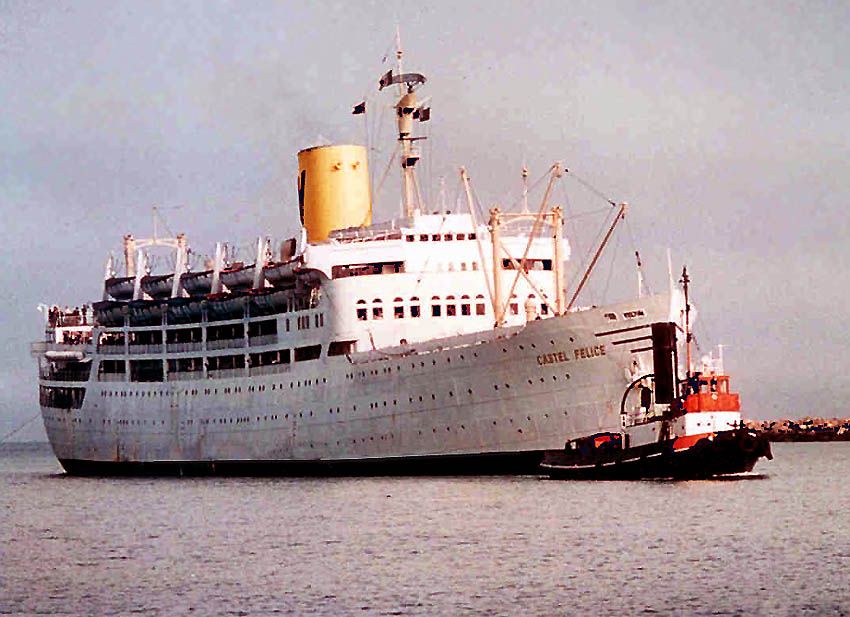
The
Castel Felice is seen arriving in the port
of Adelaide, South
Australia
Note that
her far forward lifeboats had been removed as she was due for a refit
Photograph
by & © Mark Churchman
1957 Refit:
Late in 1957 Sitmar
obtained the lucrative contract to transport assisted migrants from Britain
to Australia.
She was given another refit, including having her forward promenade deck being
partially enclosed making her ready for her new role and commenced duties on
the Australian service.
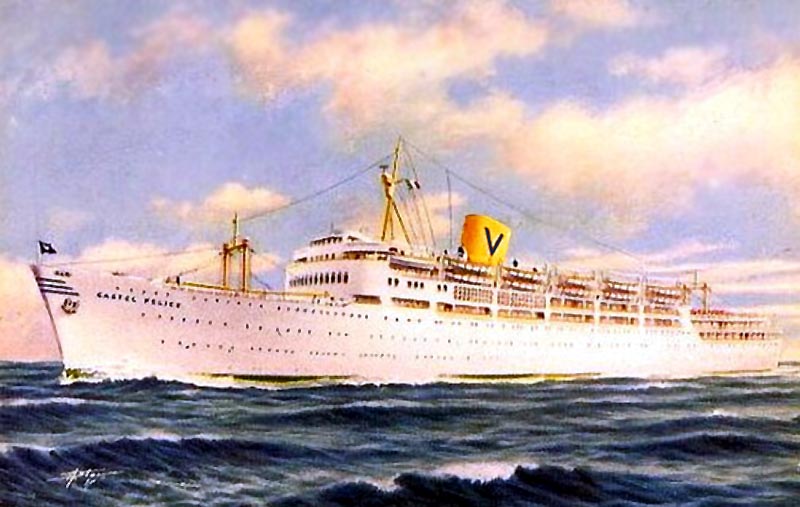
A
postcard of the Castle Felice after her
1957 refit
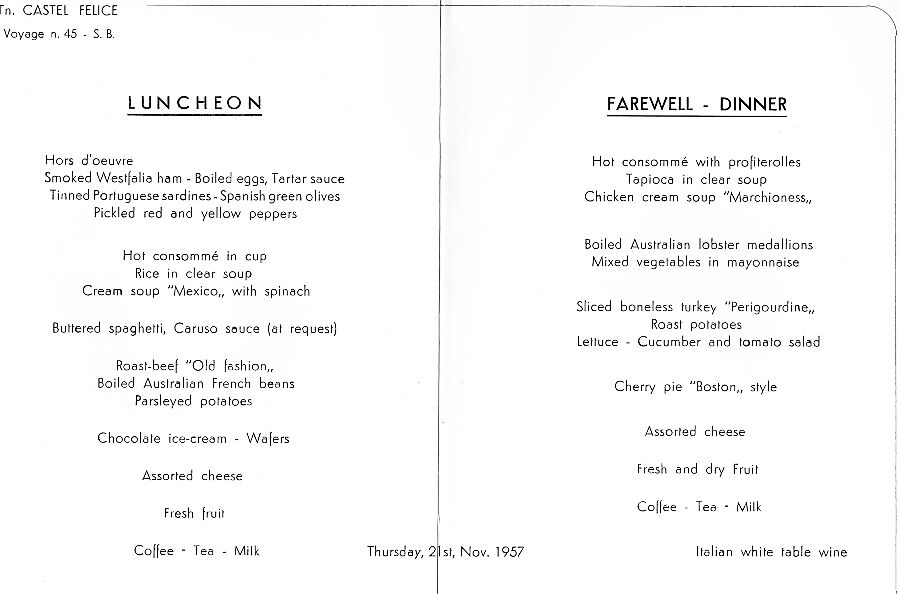
A
Luncheon Menu from Thursday November 21, 1957
Provided
by Mr. Robert Kenneth Williams
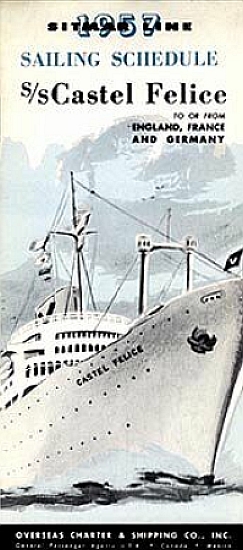
New 1957
schedules - Australia
to UK
and back
Mini Photo Album
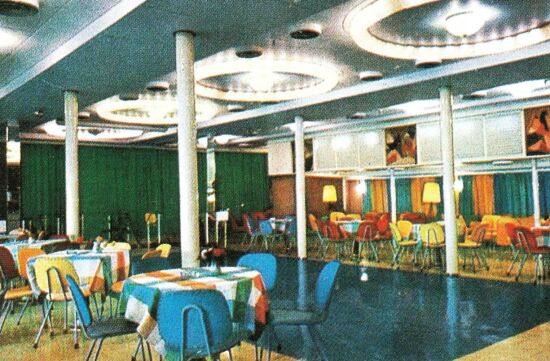
The
Main Social Hall
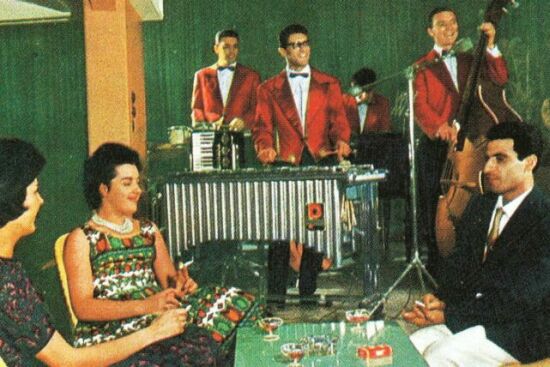
Enjoying
the ships ban in the Social Hall
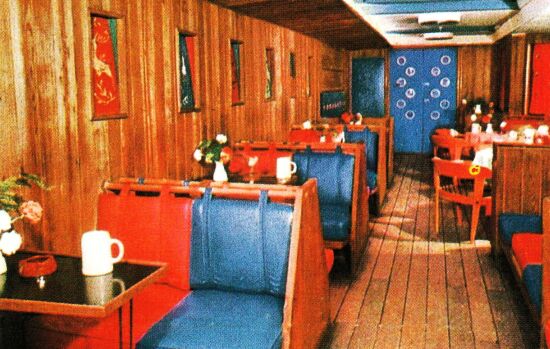
The
Tavern
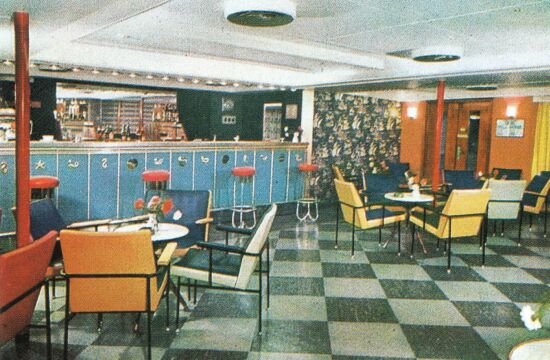
Lido
Bar
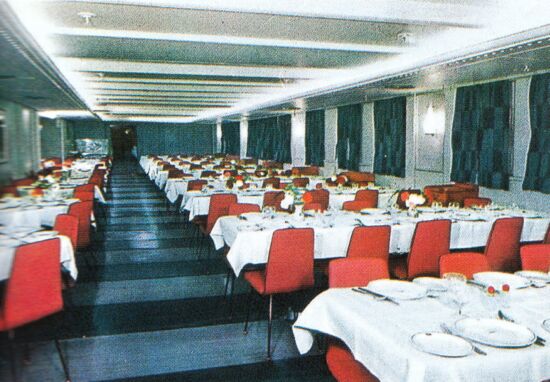
Forward
Dinning Room
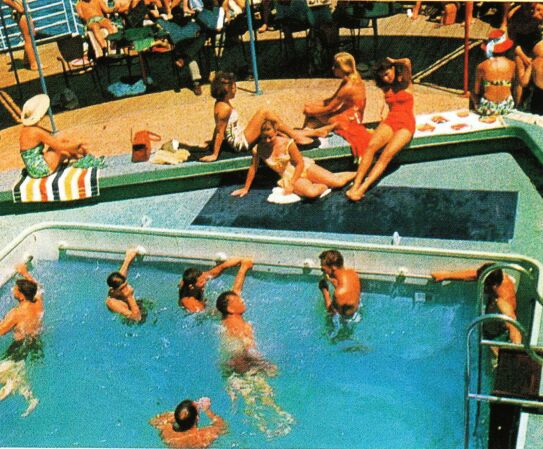
Swimming
Pool
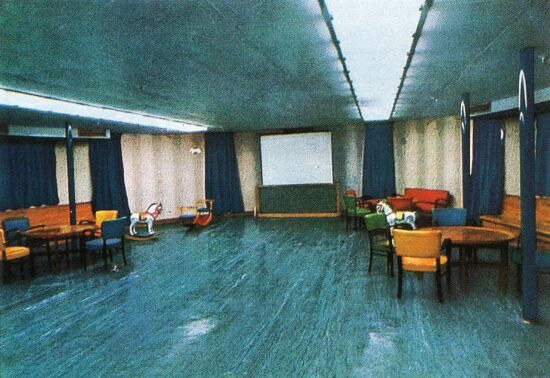
Children’s’
play room could also be used as the Cinema
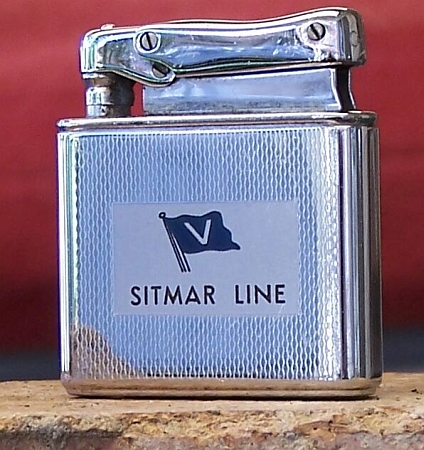 …
…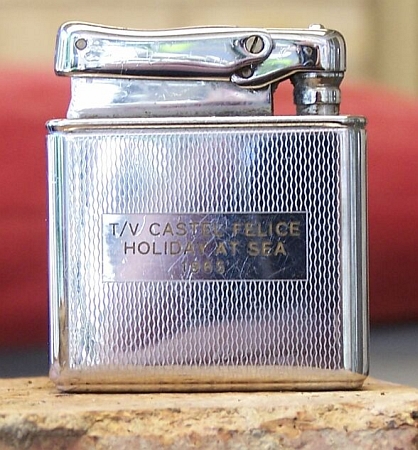
The
author’s item of memorabilia a cigarette lighter from the Castle
Felice
From
the author’s private collection
A tragic
event takes place in Naples
in 1965!
The then eleven-year-old Chris
Hemmings sailed on Sitmar Line's Castel Felice with his family early 1965 from Australia
to the UK
departing from Melbourne,
sailing via Auckland, Wellington
then back to Australia
via Brisbane to Singapore,
Colombo, Aden,
Port Said, Naples,
and Gibraltar to Southampton.
Chris tells us that there was tragic incident that took place during the voyage
for her Captain, Captain Avolio Matarese sadly passed away of a severe heart
attack as the ship was departing the port of Naples and thus the Castel Felice
had to return to her berth to offload the Captain's body and the company had to
find a another Captain. The voyage from Melbourne
to Southampton took
about seven weeks.
I wish to thank Chris Hemmings for
providing this above short story of his voyage to the UK, although be it a
rather sad story, yet it is part of this fine ship's long history!
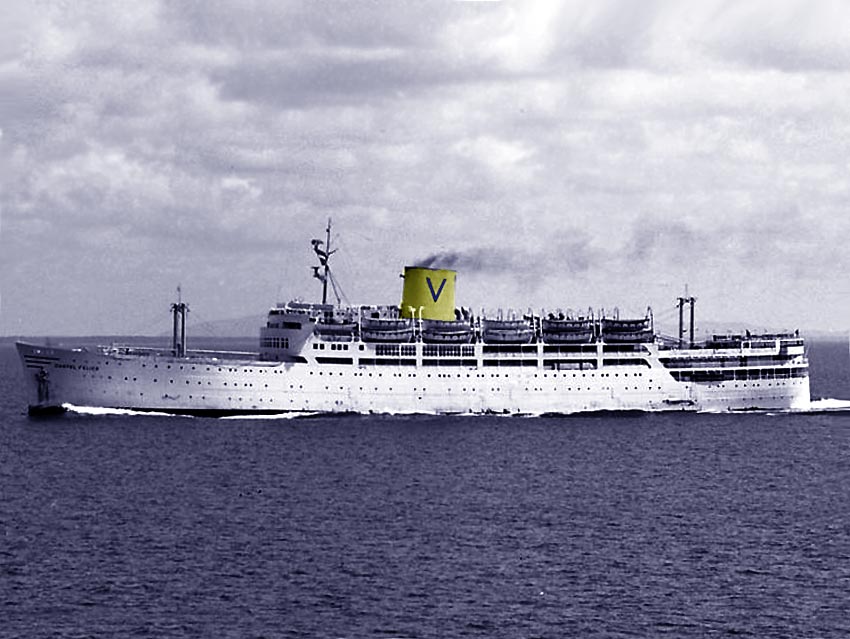
A
wonderful Photo of the SS Castel Felice at sea
****************************
The
Steve Mercer Story:
“I sailed on the TV Castle
Felice from Auckland to Southampton November/December of 1965 for 6 weeks for
just NZŁ125. It was an eventful voyage starting with a storm across the
Tasman. I was one of only a handful of passengers able to get up on day
two and I have some wonderful memories of huge seas, empty decks but the band
named Atanasio and his Happy Boys, were still playing, but mostly to an empty
Belvedere Lounge for the afternoon tea dance and I recall a little lady one
morning at the refreshment urn and then she had to balance her cups as the ship
levelled between rolls, and then having to dash along the promenaded deck until
the ship lurched the other way, it was some sight, but she got there!
The Castel Felice was a wonderfully
relaxed and such a happy ship with a most imposing tall and elegant looking
captain. We particularly liked 'little things' that made it different. For
example at midnight in the middle of a frantic dance if you put your hand out
you might likely end up with a slice of hot pizza helpfully placed in it by a
passing waiter.
Passengers were allowed to erect
washing lines on the ship's prow so at times it looked more like a Chinese
junk. Then there would be a heavy Italian voice over the loudspeaker warning
all the “Laydees” that there was a rain shower approaching and to
get the washing in. This was just absolutely priceless and that sort of thing
would never happen these days!
On the negative side whilst we were
in Aden,
a hand grenade, which fortunately turned out to be a dud, was thrown on board
and there was some panic amongst the passengers, soon a heavy British army and
police contingent came on board to collect the evidence. But thankfully it
all turned out to be a hoax.
Our call to Egypt
and sailing through the Suez Canal raised
a smile as well. Although the ship was full of British, New
Zealand and Australians, the
Egyptians obviously felt that the Italian ownership was far more important and
that ideology continued right into Cairo.
At the Continental hotel where we were to have lunch, believe it or not the
meal started with pasta, but it was in an Egyptian-style! But pasta? On board
there is a lot of pasta and it is superb, but we were looking forward to a
change!
In my teens I started to use an 8mm
camera and I filmed the entire six-week voyage on 8mm film, this includes lots
of on-board footage which I watch with great fondness now and then.
On a final point I still have a
number of menus from this wonderful and most memorable voyage.”
Steve Mercer - France.
Castel Felice remained on the Australian (including some visits
to New Zealand)
service until 1970 when sadly Sitmar Line lost their migrant contract to the
Greek Chandris Lines. It was then decided that Castel Felice would be retired
by the end of the year.
On August 15 of that
year whilst the Castel
Felice was berthed in Southampton,
a fire broke out in part of her accommodations, and Sitmar decided not to
repair the damage and kept the section where the fire damaged cabins were under
lock and key.
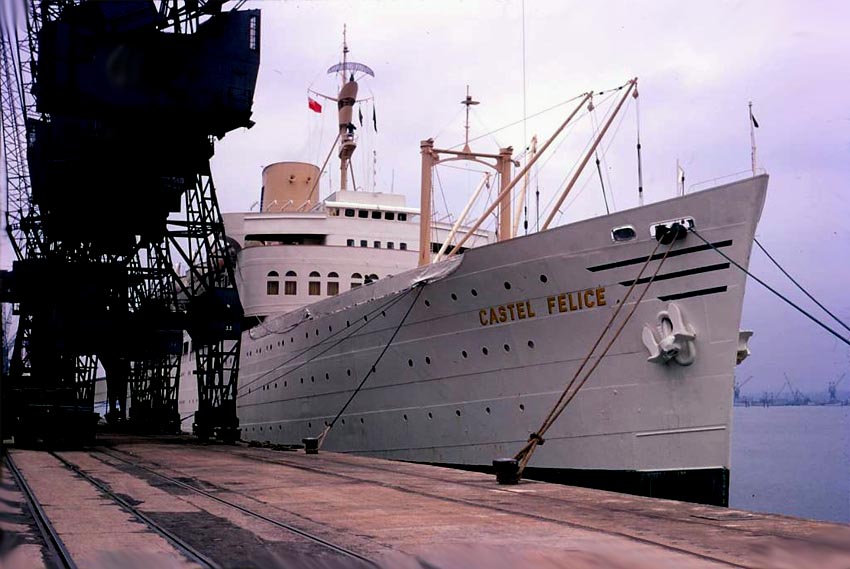
Castel
Felice is seen here during this final visit to Southampton
in August 1970
Photograph
by & © J.K. Byass
With a slightly reduced
number of passengers, SS Castel Felice departed on her final voyage to Australia,
arriving in Sydney
on Saturday September 26, 1970. She remained in Sydney
for eleven days. Whilst there, her furniture, many fittings and her stores were
removed from the ship, making her ready to sail to her Asian breakers with a
minimum crew.
The wonderful, and
much loved Sitmar liner, SS Castel Felice departed Sydney
on Wednesday October 7, 1970 and she headed north for Kaohsiung in Taiwan, where she arrived at the ship breakers’ yard
on Wednesday October 21, and soon breaking up of this 40 year old “Lady
of the Sea” commenced. In those days 40 years was being a very old ship
indeed, as in general most ships were being disposed of between 20 and maximum
30 years of age!
Memories
of a Greatly Loved Sitmar Liner!
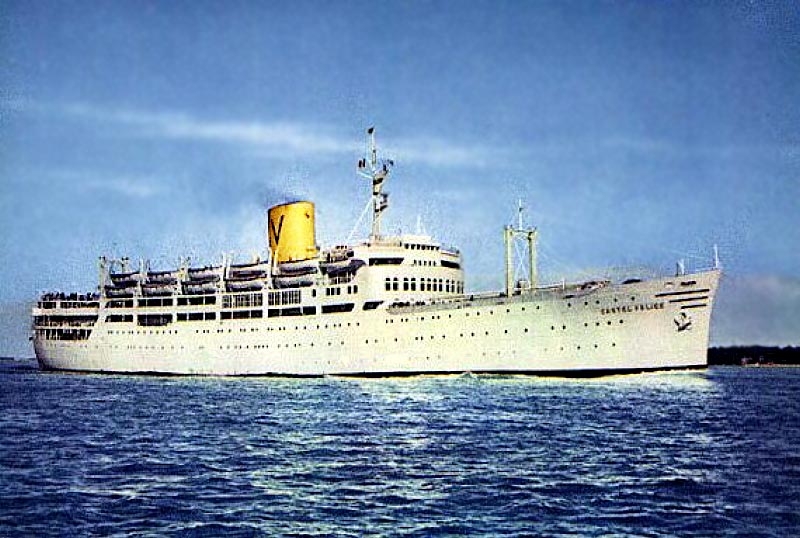
This
is the very last postcard published by Sitmar Lines of the SS Castle Felice
There
is no doubt that the SS Castel
Felice will be fondly remembered, like many Italian ships of her day, for she
had wonderful style and typical Italian finesse, which is remembered by
thousands of her past passengers!
Specifications:
Kenya as built:
Built: 1930 Alexander Stephen & Sons
Ltd., Govan,
Scotland
Yard: 529.
Official
Nr: 162509 - Kenya.
Launched: August 27, 1930.
Tonnage: 9.890 GRT.
Length: 471.3ft - 143,65m.
Beam: 64.3ft – 19.6m.
Draught: 21.11ft - 6.7m.
Machinery: 2 X SR Steam Turbines,
9,610 SHP.
Screws: Twin.
Speed: 16 knots,
17 knots service speed, maximum
Other names: Kenya
(1930), Hydra (1941), Keren (1941), Kenya
(1949), Fairstone (1950), Kenya
(1950), Keren (1951-52).
Castel
Felice:
Tonnage: 12,150 GRT.
Length: 493ft –
150.3m.
Passengers: 596 Cabin Class & 944 Third Class.
. 1955
- 28 First Class & 1,173 Tourist Class.
1957 - 1,400 One-Class.
************************
The
Castel Felice INDEX:
Castel Felice-1 - History Page - This page.
Castel Felice-2 - Cabin Plan &
the Robert Brinkhuis story 1965.
Castel
Felice-3 - My 1957 voyage to Canada
by W. D.
Hempel.
Castel Felice-4 - The Williams family sail to Australia
in 1957.
Castel Felice-4 - A family’s voyage to Australia
- on another site!
Or Return to:…….The Sitmar
Ships - INDEX - For the Other Sitmar Ships!
************************
“Blue
Water Liners sailing to the distant shores.
I watched them come, I watched them go, and I watched them die.”
************************
ENTER OUR ssMaritime MAIN INDEX
Where you will discover well over 1,300 Classic Passenger &
Passenger-Cargo Liners!
ssMaritime.com & ssMaritime.net
Where the ships of the past make history & the 1914 built MV Doulos Story
Photographs
on ssmaritime and associate pages are by the author or from the
author’s private collection. In addition there are some images that have
been provided by Shipping Companies and private photographers or collectors.
Credit is given to all contributors. However, there are some photographs
provided to me without details regarding the photographer/owner concerned. I
hereby invite if owners of these images would be so kind to make them-selves
known to me (my email address may only be found on www.ssmaritime.com),
in order that due credit may be given.
This notice covers all pages, although, and I have done my best to
ensure that all photographs are duly credited and that this notice is displaced
on each page, that is, when a page is updated!
ssMaritime
is owned & © Copyright by Reuben
Goossens - All Rights Reserved




















 …
…



